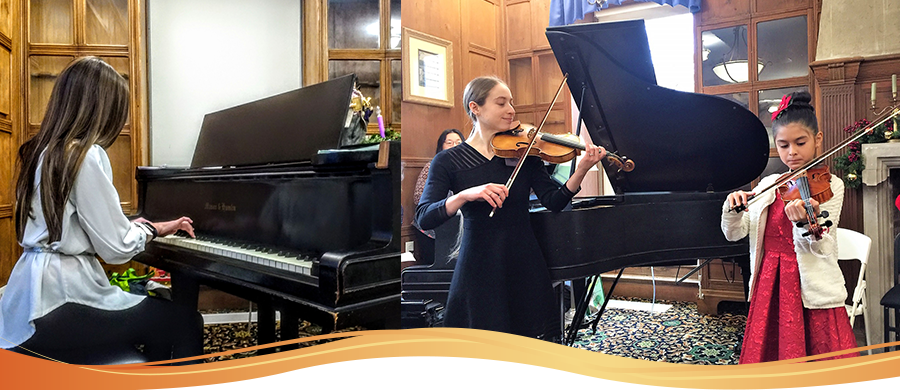
Online
Music for the Community
If you're interested in a particular category, you can sort performances by student age, instrument, singalong music, composer and so on - click on the orange tags under the text. We hope you and your family will enjoy watching our students share their music!
To have each week's videos and accompanying info sent to your inbox*, please subscribe via the orange button.
*Videos are delivered twice weekly; you can unsubscribe at any time, and we will never share or sell your info.
Subscribe to this Page
Displaying items by tag: Students age 10 to 11
Day 48 - Chopin Waltz in A Minor
Pianist age 11 plays Chopin Waltz in A minor
Week of June 1st: Lament
To quote Martin Luther King Jr., "Injustice anywhere is a threat to justice everywhere." As members of communities both smaller and larger, what affects some of us affects all of us, and if we stay silent in the face of egregious injustice, we risk becoming become complicit in it.
"Lament", performed by the composer
Day 23: Beethoven’s “Für Elise"
Pianist age 11 plays Beethoven’s “Für Elise (For Elise)”
Who was the mysterious Elise for whom Beethoven wrote this short but very famous piece? There are quite a few possible candidates!
One is German soprano Elizabeth Rockel, who sang in Beethoven’s opera Fidelio. She met with Beethoven quite often, and it’s known that he wanted to marry her at one time. Another soprano called Elise Barensfeld has also been suggested, although less is known about her.
But in fact, what Beethoven actually wrote on the manuscript was not "Für Elise" - but "Für Therese"! It’s widely acknowledged that the Therese in question was Therese Malfatti, to whom Beethoven proposed marriage in 1810, the same year he composed the piece. As further evidence, she was also the owner of the manuscript.
She must have been rather put out when - thanks to a sloppy copywriter who made the 19th century equivalent of a typo - her name on the published version of the work was changed to someone else’s!
Day 19: Schubert Sonatina in D
Violinist age 10 plays Schubert Sonatina in D, third movement
Viennese composer Franz Schubert lived only from 1797 to 1828, but he managed to compose a vast amount of music in that short time – over 600 songs, seven symphonies, a large amount of piano and chamber music (music for a small group of players), operas, and church music.
The 12th of 14 children, his musical gifts were obvious early on. He started piano lessons with his brother at 5, and violin lessons with his father at 8, but he soon outgrew their ability to teach him. After finishing his training he became a schoolteacher and also gave private music lessons, earning just enough money for his basic needs, including clothing, manuscript paper, pens, and ink, but with little to no money left over for luxuries. His life was never easy, but he did have a small circle of admirers in Vienna. Today, though, Schubert is considered one of the greatest composers of Western classical music, and his heartfelt music continues to be popular.
A sonata is a composition for one or two (occasionally three) instruments, frequently including a piano; and a sonatina literally means a “little sonata” – something shorter and easier. The piano is an equal partner here, with each performer taking turns to have the tune or the accompaniment. This lively movement in 6/8 time is based on a gigue, or jig.
Day 18: "Just Struttin' Along" by Martha Mier
Pianist age 11 plays “Just Struttin’ Along” by Martha Mier
Martha Mier is an American composer and piano teacher who was born in 1936 and lives in Lake City, FL. She has written more than 60 books of catchy solo and duet pieces for piano students from elementary to advanced level.
Many of her pieces, including this one, are written in a jazz style (remember Tick Tock the Jazz Clock?). Her music is really fun to play!
Day 16: Gavotte from Bach's Orchestral Suite in D
Violist age 11 plays "Gavotte" from Orchestral Suite in D by Bach
Bach wrote four Orchestral Suites. They all have an opening piece called an Overture, followed by a collections of movements (individual pieces) based on the dance forms of the time. These suites were very popular in Bach's day, and could be considered the “easy listening” music of the mid-18th century.
This is the third movement of Bach's third suite of this type, written about 1730 and arranged here for viola. The term Gavotte for a lively dance originated in the 1690s from Provence in southern France. The Old Provençal word gavoto (mountaineer's dance) comes from gavot, a local name for an Alpine resident, which is said to mean literally "boor" or "glutton"! You can hear that this rather heavy-footed dance might well suit a country bumpkin....
Day 14: Marching Band
Violinist age 10 plays "Marching Band" by Edwards Huws Jones
This one’s good for both marching and singing! The song has three parts, and the first and last parts are for singing along. In the middle, you can hear the band very quietly at first, as if from far away. Then they round a corner and get louder, until finally they’re right in front of you again for another rousing chorus. Grab your shakers, saucepan lids and whatever else you have to hand, and make a parade all around the house!
Mar-ching, we're mar-ching, the bugles blow, it's time to go, we're
Mar-ching, we're mar-ching, the trumpets play, we're on our way!
[Quietly] Left two three four, left two three four, left right, left right, left right, left right
[Louder] Left two three four, left two three four, left right, left right, left right, LEFT RIGHT -
Mar-ching, we're mar-ching, the bugles blow, it's time to go, we're
Mar-ching, we're mar-ching, the trumpets play, we're on our way!
Day 10: Tango by Neil Mackay
Violinist age 10 plays “Tango” by Neil Mackay
More dance music today – this time from South America. The tango combines musical elements from African, Native American and European cultures, and started in the 1880s among communities alongside the Rio de la Plata (Silver River), which is the natural border between the countries of Argentina and Uruguay. It was originally a dance for the common people, popular in dockside cafes and nightclubs, but eventually spread to Europe and North America too. Listen for the “Pa-PAH—pa pum-pum” rhythm that happens throughout the piece.
Day 8: Song of the Wind
Violinist age 10 plays Song of the Wind
Here’s another singalong song! (For the last one, see April 9th.)
Who has seen the wind, I wonder?
No-one that I know!
No-one that I know!
When the leaves are / flut-ter-ing the /
Wind is there but/ can’t be seen –
When the leaves are / flut-ter-ing the /
Wind is there I/ know.___(Repeat)
Day 2: Toccatina by Kabalevsky
Pianist age 11 plays Toccatina by Kabalevsky
Russian composer Dimitry Kabalevsky lived from 1904 – 1987. His father was a mathematician and wanted him to be one too, but he was drawn very strongly to music. He wrote symphonies, concertos, operas, ballets, chamber works, songs, theatre, film scores, and many popular pieces. During the 1930s, as movies began to have sound, he wrote film music too.
But his biggest contribution to the world of music-making was his music for children. When working as a piano teacher he felt that there wasn’t enough good music for children learning piano. So he set out to write easy music that had appropriate technical challenges for students, but at the same time would be interesting and help develop children’s musical sensitivity. This Toccatina is one of those pieces.


